Auto-Parking System Challenge


By James R. Healey, USA Today and Kelsey Mays, Cars.com
The simple act of parking your car is the focus of extraordinary technology. Backup cameras and warning sensors have become old hat. Surround-view cameras are slowly arriving, and the big step is cars that parallel-park themselves.
Well, sort of; they find a parking spot that’s big enough and they do the wheel work. You still must operate the accelerator and brake pedals to be sure you get out of the traffic flow quickly and then don’t whack the parked car ahead of or behind you.
Lexus introduced auto-parking in the U.S. on its 2007 LS 460 full-size sedan. That system had a high gee-whiz factor, but was cumbersome to use. It’s gone now — discontinued after the 2012 model. Almost nobody bought it, so Lexus “removed that option,” spokesman Bill Kwong said.
Though the luxury brand has axed auto-parking, mainstream Toyota still sells the feature as a Prius v option. It’s also available as a stand-alone feature ($395) on the $24,000 Ford Focus Titanium. Auto-parking no longer is strictly a luxury item, though that’s where it’s mainly found.
Auto-parking systems become mainstream
Now that these systems are working themselves into the mainstream, USA Today and Cars.com wanted to find out if today’s parking systems work better than the original Lexus setup, and thus are more likely to become popular.

We also wanted to compare the mainstream systems to those on luxury cars, and how they all stack up versus doing the parallel parking yourself with the aid of 360-degree cameras and warnings systems that tell when the car’s too close to others and you need to stop or maneuver.
We invited seven automakers to take part in our parking challenge. Four accepted: Ford sent an Escape SUV, Land Rover provided a Range Rover Evoque SUV and Mercedes-Benz sent a GL350 diesel SUV; all had an auto-parking system. Nissan supplied a Pathfinder with surround-view cameras.
Toyota declined because it doesn’t think there’s much interest in the feature. Audi said it didn’t have an A8 sedan with 360-degree-view camera system available to loan for the test.
BMW said it didn’t have a car available with its automatic system, called Parking Assistant. Park Assistant is available on rear-wheel-drive versions of 3 Series, 5 Series (including GT), 6 Series and 7 Series vehicles.

How we tested the systems
Our three experts — veterans of many test drives — made three timed attempts to parallel-park each vehicle in a space between two parked vehicles. The space was adjusted to be 6 feet longer than the vehicle being tested to make the “gap” competitive for all.
The “curb” in this case was a low rock wall, which was about 21 inches high, and made the task tougher.
That’s because a conventional curb is low enough that a driver can back in until the rear wheels bump the curb, letting the vehicle’s rear extend over it during the maneuver. Not so in our test, making it also an evaluation of how well the auto-park was integrated with the backup camera and parking sensors.
The auto-parking systems work by using sensors to identify a spot big enough for the car to fit, and signaling the driver when it has found one. The Mercedes-Benz assumes the driver is searching for a parking spot any time the vehicle is creeping along. The others require a driver to activate the parking search by pushing a button.

Once a spot is identified, it messages the driver on the instrument panel. The driver must continue moving forward slowly until the system judges the car to be properly positioned and alerts the driver to halt.
It’s then a matter of shifting into Reverse, releasing the steering wheel (not an easy decision at first), hovering your foot over the brake pedal, and watching the cameras and listening to the warning beeps to tell when the car is coming close to the car behind it (and the rock wall, in our case). Hit the brake, shift into Drive and let the system use its auto-steering to line up the vehicle within the parking spot.
Scoring was simple. We took each driver’s best time for each vehicle and averaged them to get that vehicle’s score. Lower times equal better scores.
How the systems stacked up
It was a coincidence that the tested vehicles all were SUVs; most systems are available on other types of vehicles, too.
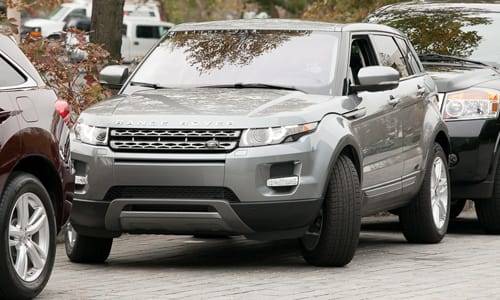

Systems tested and performance time: Park Assist and Surround Camera, 21.9 seconds, and the consensus pick for easiest to use.
Available on: Most 2013 Range Rovers
Least-expensive with the system: $48,595 for the Range Rover Evoque Pure Premium AWD

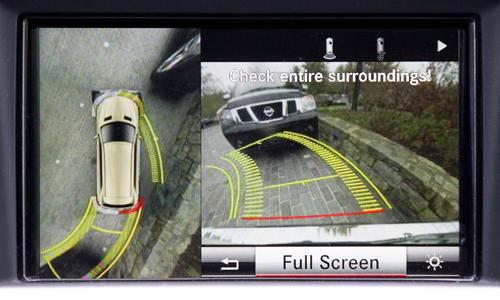
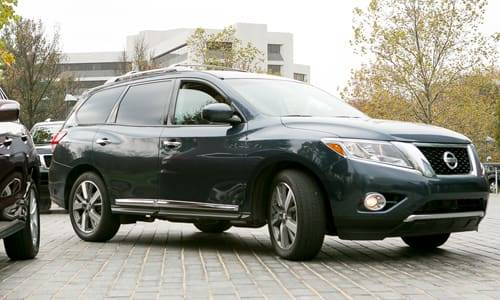
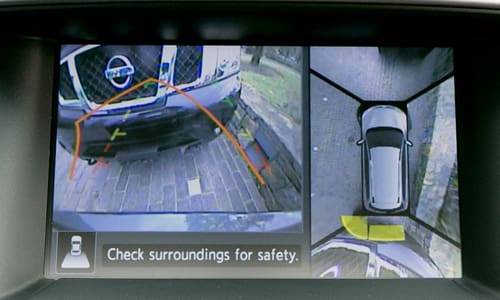
System tested and performance time: Around-View Monitor, 30.5 seconds
Available on: Pathfinder, Quest and Rogue; Infiniti EX, FX, JX and QX
Least-expensive version: $29,715, Rogue SL front-wheel drive. Around-View blends views from several cameras to display on a screen the area near both sides and the front and back of the vehicle, making it easier to judge how near or far an obstacle is.
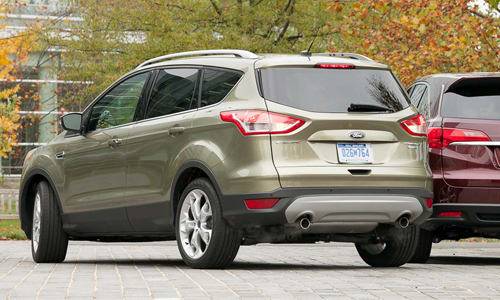

Systems tested and their performance: Active Park Assist, 31 seconds
Available on: C-Max hybrid, C-Max Energi, Explorer, Escape, Flex, Focus, Fusion, Fusion Energi, Fusion Hybrid and Taurus; Lincoln MKS, MKT and MKZ.
Least-expensive version: $24,390, Focus Titanium sedan
All three auto-park systems we tested will fine-tune the car’s position within the space. The driver brakes to a stop, shifts to Drive and the auto-park resumes steering control as the vehicle moves forward. The driver stops going forward, shifts back into Reverse and the auto-park again works to place the vehicle just-so in the space.
Eventually the systems decide the car’s as good as it’s going to get and stops steering. The Ford seems fussiest about lining up the vehicle, continuing the automatic steering through multiple back- and-forth cycles.
All three auto-park systems can be set to allow parking on the right, which is normal, or the left, as on a one-way street. No system will “unpark.” It’s up to the driver to get out of the space and into traffic.
General observations
Our panel of parkers:
The auto-parking systems still are rarities and industry trackers who normally tally such features don’t keep tabs on them.
Mercedes-Benz says it should be on 40% to 80% of GL-class SUVs, depending on the model. “The Park Assist systems are totally new, so no ‘take’ rates yet,” said Land Rover spokesman Wayne Kung.
Check out the video below:
Related
The Lexus LS460: It Really Does Park Itself
Ford’s Automated Parallel Parking System
More Safety News on Cars.com

Former Assistant Managing Editor-News Kelsey Mays likes quality, reliability, safety and practicality. But he also likes a fair price.
Featured stories




